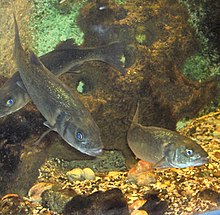| Dicentrarchus | |
|---|---|

| |
| European Seabass (D. labrax) | |
| Scientific classification | |
| Domain: | Eukaryota |
| Kingdom: | Animalia |
| Phylum: | Chordata |
| Class: | Actinopterygii |
| Order: | Acanthuriformes |
| Family: | Moronidae |
| Genus: | Dicentrarchus T. N. Gill, 1860 |
| Type species | |
| Perca elongata É. Geoffroy St. Hilaire, 1817 | |
| Synonyms | |
| |
Dicentrarchus is a genus of ray-finned fishes belonging to the family Moronidae, the temperate basses. The two species in this genus are found in the eastern Atlantic Ocean and the Mediterranean Sea. The species in this genus are economically important food fishes.
Classification
Dicentrarchus was first proposed as a monospecific genus in 1860 by the American ichthyologist Theodore Gill with Perca elongata, which had been described in 1817 by Étienne Geoffroy Saint-Hilaire from the Mediterranean Sea of Egypt, designated as its type species. The genus is one of two in the family Moronidae which belongs to the order Moroniformes.
Etymology
Dicentrarchus is a combination of di, “two”, with kentron, “thorn” or “spine”, and archos, “anus”. This is an allusion to the two anal fin spines Gill thought the European seabass had. In fact, both species have three spines in their anal fins and Gill admitted he did not actually examine a specimen.
Species
Dicentrarchus currently has two species classified within it:
| Image | Scientific name | Common Name | Distribution |
|---|---|---|---|
 |
Dicentrarchus labrax (Linnaeus, 1758) | European seabass | eastern Atlantic Ocean (from Norway to Senegal), the Mediterranean Sea, and the Black Sea |
 |
Dicentrarchus punctatus (Bloch, 1792) | spotted seabass | coastal eastern Atlantic Ocean from the English Channel to the Canary Islands and Senegal, as well as through the Mediterranean Sea |
Characteristics
Dicentrarchus seabasses have a finely serrated rear margin to the preoperculum with the lower edge having robust, forward pointing denticles. There are two flat sines on the operculum. They have two separated dorsal fins and their caudal fin is moderately forked. The largest of these fishes is the European seabass which has a maximum published total length of 103 cm (41 in).
Distribution, habitat and biology
Dicentrarchus seabasses are coastal fishes found in the eastern Atlantic, from Norway south to Senegal, and the Mediterranean. These fishes are euryhaline and eurythermal. They are sociable when young. Their eggs and larvae are pelagic. These fishes are predatory, preying on crustaceans and other fishes.
Utilisation
Dicentrarchus seabasses have a very palatable flesh and are economically important.
References
- ^ Eschmeyer, William N.; Fricke, Ron & van der Laan, Richard (eds.). "Genera in the family Moronidae". Catalog of Fishes. California Academy of Sciences. Retrieved 27 March 2023.
- Eschmeyer, William N.; Fricke, Ron & van der Laan, Richard (eds.). "Species in the genus Dicentrarchus". Catalog of Fishes. California Academy of Sciences. Retrieved 27 March 2023.
- J. S. Nelson; T. C. Grande; M. V. H. Wilson (2016). Fishes of the World (5th ed.). Wiley. pp. 495–497. ISBN 978-1-118-34233-6. Archived from the original on 2019-04-08. Retrieved 2023-03-27.
- Christopher Scharpf & Kenneth J. Lazara, eds. (9 March 2023). "Series Eupercaria (Incertae sedis): Families Callanthidae, Centrogenyidae, Dinopercidae, Emmelichthyidae, Malacanthidae, Monodactylidae, Moronidae, Parascorpididae, Sciaenidae and Sillagidae". The ETYFish Project Fish Name Etymology Database. Christopher Scharpf and Kenneth J. Lazara. Archived from the original on 17 February 2022. Retrieved 24 March 2023.
- ^ Froese, Rainer; Pauly, Daniel (eds.). "Species in genus Dicentrarchus". FishBase. February 2023 version.
- ^ J-C Hureau. "Dicentrarchus". Fishes of the Northeast Atlantic and the Mediterranean. Naturalis Biodiversity Center.